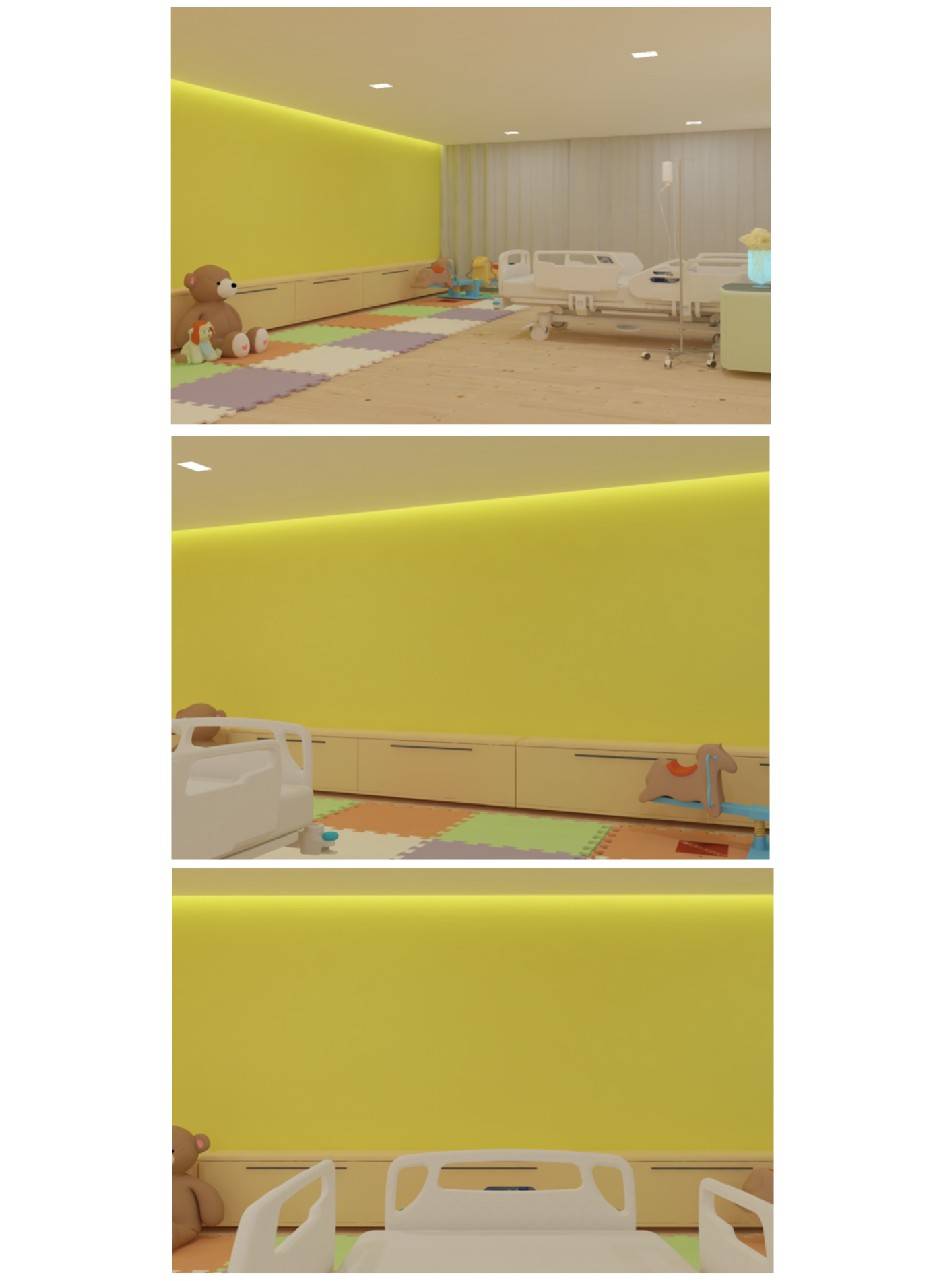การตอบสนองทางอารมณ์ต่อสี และการตกแต่งผนัง ของห้องพักผู้ป่วยเด็ก
คำสำคัญ:
สี, ลวดลายตกแต่ง, อารมณ์, ห้องพักผู้ป่วยเด็ก, การตอบสนองทางอารมณ์บทคัดย่อ
กุมารเวชกรรมในธุรกิจโรงพยาบาลเอกชนมีการขยายตัวอย่างต่อเนื่องเพิ่มขึ้นทุกปี และมีการแข่งขันทางการตลาดที่สูง การออกแบบสี และลวดลายตกแต่งบนผนังในห้องพักผู้ป่วยเด็กเป็นเทคนิคหนึ่งที่สามารถสร้างบรรยากาศที่ดี มีผลต่อผู้ปกครองในการตัดสินใจแทนบุตร หลานเข้ารับการรักษา งานวิจัยนี้จึงมีวัตถุประสงค์ เพื่อศึกษาอิทธิพลของคุณลักษณะสี และลวดลายตกแต่งผนังที่แตกต่างกันภายในสภาพแวดล้อมห้องพักผู้ป่วยเด็ก โดยกำหนดตัวแปรต้นเป็นรูปแบบผนัง ซึ่งประกอบด้วยผนัง 9 รูปแบบ ได้แก่ ผนังสีเดี่ยว 5 สี และผนังตกแต่งลวดลายธรรมชาติ 4 รูปแบบ ที่มีความแตกต่างด้านโทนสี และลวดลายตกแต่งผนัง จากการทดสอบมีผู้เข้าร่วมการทดสอบจำนวน 64 คน ใช้วิธีการทดสอบโดยวิธีการดูรูปภาพจำลอง และตอบแบบสอบถาม วิเคราะห์ข้อมูลด้วยวิธีการเปรียบเทียบ t-test ผลการวิจัยแสดงให้เห็นว่า การมีสีและลวดลายตกแต่งในสภาพแวดล้อมนั้นส่งผลดีกับสภาพแวดล้อมห้องพักผู้ป่วยเด็ก คุณลักษณะสี และลวดลายตกแต่งผนังที่แตกต่างกัน ส่งผลต่ออารมณ์อย่างมีนัยสำคัญทางสถิติ (p<0.05) ความรู้สึกด้านสภาพอารมณ์ ผนังลวดลายตกแต่งสีฟ้า ส่งผลดีที่สุดต่อความรู้สึกสบาย ความรู้สึกมีชีวิตชีวา ความรู้สึกผ่อนคลาย และความรู้สึกสบายใจมากที่สุด ตามมาด้วยผนังสีฟ้า ส่งผลดีที่สุดต่อความรู้สึกพึงพอใจ และความรู้สึกตื่น ในขณะที่ผนังสีชมพู ส่งผลดีที่สุดต่อความรู้สึกสวยงาม และผนังลวดลายตกแต่งสีเหลือง นั้นกลับส่งผลดีที่สุดต่อความรู้สึกตื่นตัวเช่นเดียวกันกับผนังสีฟ้า สำหรับความรู้สึกด้านสภาพแวดล้อม ผนังลวดลายตกแต่งสีฟ้า ส่งผลดีที่สุดต่อความรู้สึกปลอดภัยมากที่สุด ในขณะที่ผนังสีฟ้า นั้นส่งผลดีที่สุดต่อความรู้สึกสะอาด งานวิจัยนี้สรุปได้ว่าคุณลักษณะของสี และลวดลายตกแต่งผนังเป็นปัจจัยสำคัญในการออกแบบสภาพแวดล้อมห้องพักผู้ป่วยเด็ก มีส่วนสร้างอารมณ์ในเชิงบวก จูงใจผู้ปกครองตัดสินใจแทนบุตร หลานเข้ารับการรักษาในโรงพยาบาล สำหรับการต่อยอดด้านการศึกษาในอนาคต ควรพิจารณาปัจจัยสภาพแวดล้อมด้านอื่น เช่น ปัจจัยด้านแสงสว่างร่วมด้วย
References
Abbas, Y. M. & Ghazali, R. (2012). Healing environment pediatric wards status and design trend. Procedia -Social and behavioral sciences, 49, 28-38.
Brennam, W. M., Ames, E. W. & Moore, R. W. (1966). Age differences in infants’ attention to patterns of different complexities. Science, 151 (3708), 354-356.
Cifter, A. S. & Cifter, M. (2017). A review on future directions in hospital spatial designs with a focus on patient experience. The Design Journal, 20 (sup1), S1998-S2009.
Coad, J. (2008). Children and young people’s preference of thematic design and colour for their hospital environment. Journal of Child Health Care, 12 (1), 33–48.
Ghazali, R., Abbas, Y. M. & Jalalkamali, N. (2013). Healing environment in paediatric wards: from research to practice. Procedia -Social and Behavioral Sciences, 105, 229-238.
Huisman, M., et al. (2012). Healing environment: a review of the impact of physical environmental factors on users. Building and Environment, 58, 70-80.
Jayakaran, T. G., et al. (2017). Preferences and choices of a child concerning the environment in a pediatric dental operatory. Dental Research Journal, 14, 183-187.
Karmel, B. Z. (1969). The effect of age, complexity, and amount of contour on pattern preferences in human infants. Journal of Experimental Child Psychology, 7 (2), 339-354.
Lewis, M., Kagan, J. & Kalafat, J. (1966). Patterns of fixation in the young infant. Child Development, 37 (2), 331-341.
Manager online. (2016). Rongphayaban Phyathai 2 thum 150 lan phut sun sukkhaphap dek 24 chuamong. (In Thai) [Phyathai hospital 2 invest 150 million baht to build a 24-hour children’s health center]. Retrieved January, 18, 2019, from https://mgronline.com/business/detail/9590000082411
Monti, F., et al. (2012). Pictorial intervention in a pediatric hospital environment: effects on parental affective perception of the unit. Journal of Environmental Psychology, 32 (3), 216-224.
Nightingale, F. (1859). Notes on nursing: what it is, and what it is not. Philadelphia: Lippincott company.
Ninkitsaranont, P. (2019). Naeonom thurakit utsahakam pi 2562-2564 thurakit rongphayaban ekkachon. (In Thai) [Business trend Industry 2019 – 2021 private hospital business]. Retrieved December, 2018, from https://www.krungsri.com/bank/getmedia/42e5f42d-4465-4304-92af-60e3c2539460/IO_Private_Hospital_190624_TH_EX.aspx
Park, J. G. (2009). Color perception in pediatric patient room design healthy children vs pediatric patients. Health Environments Research & Design Journal. 2 (3), 6-28.
Taylor, C., et al. (2013). Color preferences in infants and adults are different. Psychonomic Society. 20 (5), 916-922.
Ulrich, R. S., et al. (2008). A review of the research literature on evidence based healthcare design. Health Environments Research & Design Journal, 1 (3), 61-125.
Waller, S. & Masterson, A. (2015). Designing dementia-friendly hospital environments. Future Healthcare Journal, 2 (1), 63-68.
Wongprawin, T. & Inkarojrit, V. (2017). Itthiphon khong si nai saphabwaetlom tee song phon tor kwam khriat khong phu sung-ayu chao Thai. (In Thai) [The influence of environmental color on Thai elderly people’s stress] (Master’s thesis). Bangkok: Chulalongkorn University.
Yamsai, P. & Inkarojrit, V. (2017). Itthiphon khong si watsadu phuenphio lae unhaphum si khong saeng tee mee phonkrathob tor karn rapru dan kwam pen yu tee di lae phap chotcham khong hong phak phupuai rongphayaban radab sung. (In Thai) [Effect of color, finishing and lighting on the perception of well-being and image of up-scale hospital ward] (Master’s thesis). Bangkok: Chulalongkorn University.



